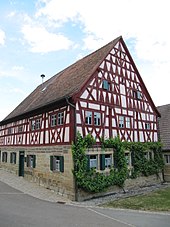Town hall (Mönchsondheim)
The former town hall (address An der Kirchenburg 2 , formerly house number 7) of the Mönchsondheim district of Iphöfer is located in the center of the village and is now part of the Mönchsondheim church castle museum .
history
The history of the Mönchsondheim town hall is closely linked to that of the town itself. The village had been under the rule of the Cistercian monastery of Ebrach since the late Middle Ages , but the residents nevertheless adopted the Protestant denomination in the 16th century. In order to maintain their religious independence from the Catholic monastery, the Mönchsondheimers placed themselves under the protection of the Margraves of Brandenburg-Ansbach in 1533 . The self-confidence of the residents thus gained is also underlined by the construction of their own town hall.
It was completed in 1557 and has the typical multifunctionality of a Franconian town hall. While a blacksmith's shop including an apartment for the blacksmith and a bakery was housed on the ground floor, the "council room" was located on the upper floor. The jury and field jury met here . The town hall hall in front of the parlor was also used in many ways. In addition to the community meeting, it served as a wedding hall, the church consecration dance and the funeral drink also took place here.
In 1806 the Ebrach Monastery, which had ruled Mönchsondheim for centuries, was secularized . With him, the village court and the office of mayor , who, as the representative of the authorities, was responsible for political decisions, disappeared . The inn soon assumed the function of a meeting place for all kinds of celebrations . The town hall experienced a further loss of importance when the community blacksmith moved into its own building in Kirchstrasse 15 in 1880.
Forty years earlier, in 1840, the building, which had previously been made entirely of half-timbering, had been reinforced. The weathering damage to the wood had become a permanent burden on the community budget. Which is why the ground floor was now made of massive stone. In 1927 the community bakery in the town hall was enlarged, including the premises of the former forge. In the years that followed, a post office was also housed in the bakery . The bakery and post office moved out of the town hall in 1958.
Now the building was limited to its core function. The municipality council of Mönchsondheim met on the upper floor until 1972, when the municipality reform Mönchsondheim became part of the city of Iphofen. However, the town hall was soon converted into part of the Mönchsondheim Fortified Church Museum. Today it serves as a meeting room for local associations. The former town hall is classified as an architectural monument by the Bavarian State Office for the Preservation of Monuments .
Architecture and interior design
The former town hall presents itself as a two-storey eaves gable roof structure . The ground floor was completely bricked up in the 19th century, but, like the upper floor, was originally made of timber . The half-timbering of the upper floor was exposed again during a renovation in 1995 and is now in the condition from around 1600. In particular, the red wood and white partitions contribute to this impression.
The windowing of the entire building shows the typical inconsistency of an early modern building. Long double windows alternate with smaller single windows. The half-timbering is also typically Main Franconian . It is arranged very densely and has so-called St. Andrew's crosses in an almost frieze-like sequence. A coach house can be found next to the town hall, which for a long time served as a wood store. Around 1900 the cattle scale of the village was built on the property.
See also
literature
- Reinhard Hüßner: A museum in its prime. 25 years of Kirchenburgmuseum Mönchsondheim. (= The Steigerwald - magazine of a Franconian landscape. Volume 26, No. 2/2006). Burgebrach 2006.
- Sibylle Kneuer: Mönchsondheim between 1300 and 1600 - The development of the village community . In: Yearbook for the district of Kitzingen. Under the spell of the Schwanberg 2014 . Dettelbach 2014. pp. 167-190.
Web links
Individual evidence
- ^ Kneuer, Sibylle: Mönchsondheim between 1300 and 1600 . P. 174.
- ↑ Hüßner, Reinhard: A museum in the prime of life . P. 131.
- ↑ Hüßner, Reinhard: A museum in the prime of life . P. 132.
- ↑ Hüßner, Reinhard: A museum in the prime of life . P. 133.
Coordinates: 49 ° 40 ′ 1.4 ″ N , 10 ° 16 ′ 43.1 ″ E

